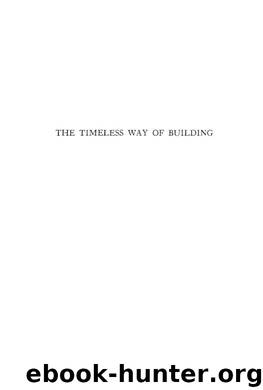The Timeless Way Of Building by Christopher Alexander

Author:Christopher Alexander
Language: eng
Format: epub
Tags: The Timeless Way of Building, Christopher Alexander, Architecture
Published: 1979-08-31T04:00:00+00:00
// is clear } then, that we can discover living patterns, and share them, and reach some reasonable degree of confidence in their reality.
The patterns cover every range of scale in our surroundings: the largest patterns cover aspects of regional structure, middle range fatterns cover the shape and activity of buildings, and the smallest fat-terns deal with the actual physical materials and structures out of which the buildings must be made.
So far, though, we have said little about language. In this chapter we shall see how it is possible to put these patterns together to form coherent languages.
As we shall see, the possibility of language is latent in the fact that patterns are not isolated. But it comes out, in its full force, when we experience the desire to make something. As soon as we want to make something—anything—a small thing like a garden seat, a large thing like a neighborhood—and want to see it whole, then we experience the desire which puts a structure on the patterns, and makes language out of them.
Imagine that I am going to build a garden.
From chapters 10, II, and 12, we know now that the garden will not live, nor be a beautiful and stirring place, unless we have a powerful, and deep and living language for the garden—before we start to lay it out.
Somehow, then, I must try to find, or create for myself, a pattern language for a garden.
THE GATE
One way to start a language for a garden is to get some patterns from the pattern language we have published in volume 2.
If you go through the patterns in that language, choosing the patterns for a garden which seem relevant for you, you might, for instance, choose the following list of patterns:
HALF-HIDDEN GARDEN
TERRACED SLOPE
FRUIT TREES
TREE PLACES
GARDEN GROWING WILD
ENTRANCE TRANSITION
COURTYARDS WHICH LIVE
ROOF GARDEN
BUILDING EDGE
SUNNY PLACE
OUTDOOR ROOM
SIX-FOOT BALCONY
CONNECTION TO THE EARTH
GREENHOUSE
GARDEN SEAT
But what is it y now y which makes these patterns form a language?
I can get these patterns from the published language, simply ticking off the ones I like, and writing them down in the order of the larger language.
THE STRUCTURE OF A LANGUAGE
And, of course, I might also include patterns which I have invented myself, or which my friends have told me about—mixed in with the others.
But what makes a language of them; and what makes this language whole?
The structure of a pattern language is created by the fact that individual patterns are not isolated.
To understand this idea, fully, think about the pattern "garage," and concentrate, in particular, on the garage of a single-family house. How do you know that a particular building that you see is a garage?
Of course, you recognize it partly by the smaller patterns it contains: by the fact that it is the size of a car, by the fact that it has small windows or none at all, by the fact that it has a large, full-height door in front, etc. These facts are defined by the pattern which we call "garage."
But the pattern of the garage and the smaller patterns it contains are not enough to define the garage fully.
Download
This site does not store any files on its server. We only index and link to content provided by other sites. Please contact the content providers to delete copyright contents if any and email us, we'll remove relevant links or contents immediately.
| Automotive | Engineering |
| Transportation |
Whiskies Galore by Ian Buxton(40865)
Introduction to Aircraft Design (Cambridge Aerospace Series) by John P. Fielding(32386)
Small Unmanned Fixed-wing Aircraft Design by Andrew J. Keane Andras Sobester James P. Scanlan & András Sóbester & James P. Scanlan(32165)
Craft Beer for the Homebrewer by Michael Agnew(17485)
Turbulence by E. J. Noyes(7101)
The Complete Stick Figure Physics Tutorials by Allen Sarah(6670)
Kaplan MCAT General Chemistry Review by Kaplan(6098)
The Thirst by Nesbo Jo(5830)
Bad Blood by John Carreyrou(5812)
Learning SQL by Alan Beaulieu(5463)
Weapons of Math Destruction by Cathy O'Neil(5093)
Man-made Catastrophes and Risk Information Concealment by Dmitry Chernov & Didier Sornette(4797)
iGen by Jean M. Twenge(4725)
Digital Minimalism by Cal Newport;(4647)
Life 3.0: Being Human in the Age of Artificial Intelligence by Tegmark Max(4552)
Audition by Ryu Murakami(4138)
Electronic Devices & Circuits by Jacob Millman & Christos C. Halkias(4079)
1,001 ASVAB Practice Questions For Dummies by Powers Rod(4069)
Pale Blue Dot by Carl Sagan(4054)
